traction control CHEVROLET CAMARO 1996 4.G Owners Manual
[x] Cancel search | Manufacturer: CHEVROLET, Model Year: 1996, Model line: CAMARO, Model: CHEVROLET CAMARO 1996 4.GPages: 402, PDF Size: 21.38 MB
Page 102 of 402
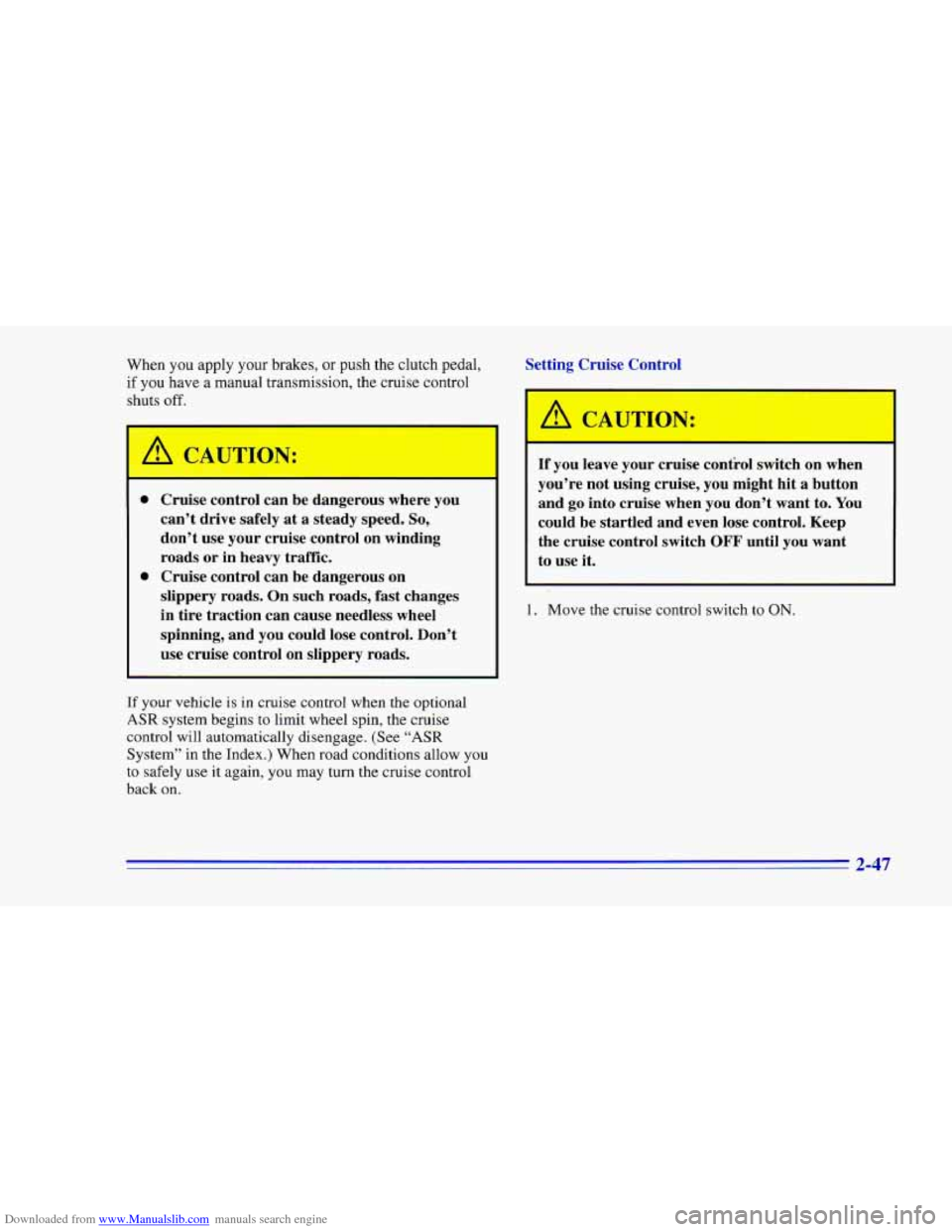
Downloaded from www.Manualslib.com manuals search engine When you apply your brakes, or push the clutch pedal,
if you have a manual transmission, the cruise control
shuts
off.
Setting Cruise Control
0 Cruise control can be dangerous where you
can’t drive safely at a steady speed.
So,
don’t use your cruise control on winding
roads or in heavy traffic.
slippery roads. On such roads, fast changes
in tire traction can cause needless wheel
spinning, and you could lose control. Don’t
use cruise control on slippery roads.
0 Cruise control can be dangerous on
If your vehicle is in cruise control when the optional
ASR system begins to limit wheel spin, the cruise
control will automatically disengage. (See
“ASR
System” in the Index.) When road conditions allow you
to safely use it again, you may turn the cruise control
back
on.
L
QT’TIO’’:
If you leave your cruise contirol switch on when
you’re not using cruise, you might hit
a button
and go into cruise when you don’t want to. You
could be startled and even lose control. Keep
the cruise control switch
OFF until you want
to use it.
1. Move the cruise control switch to ON.
2-47
Page 173 of 402
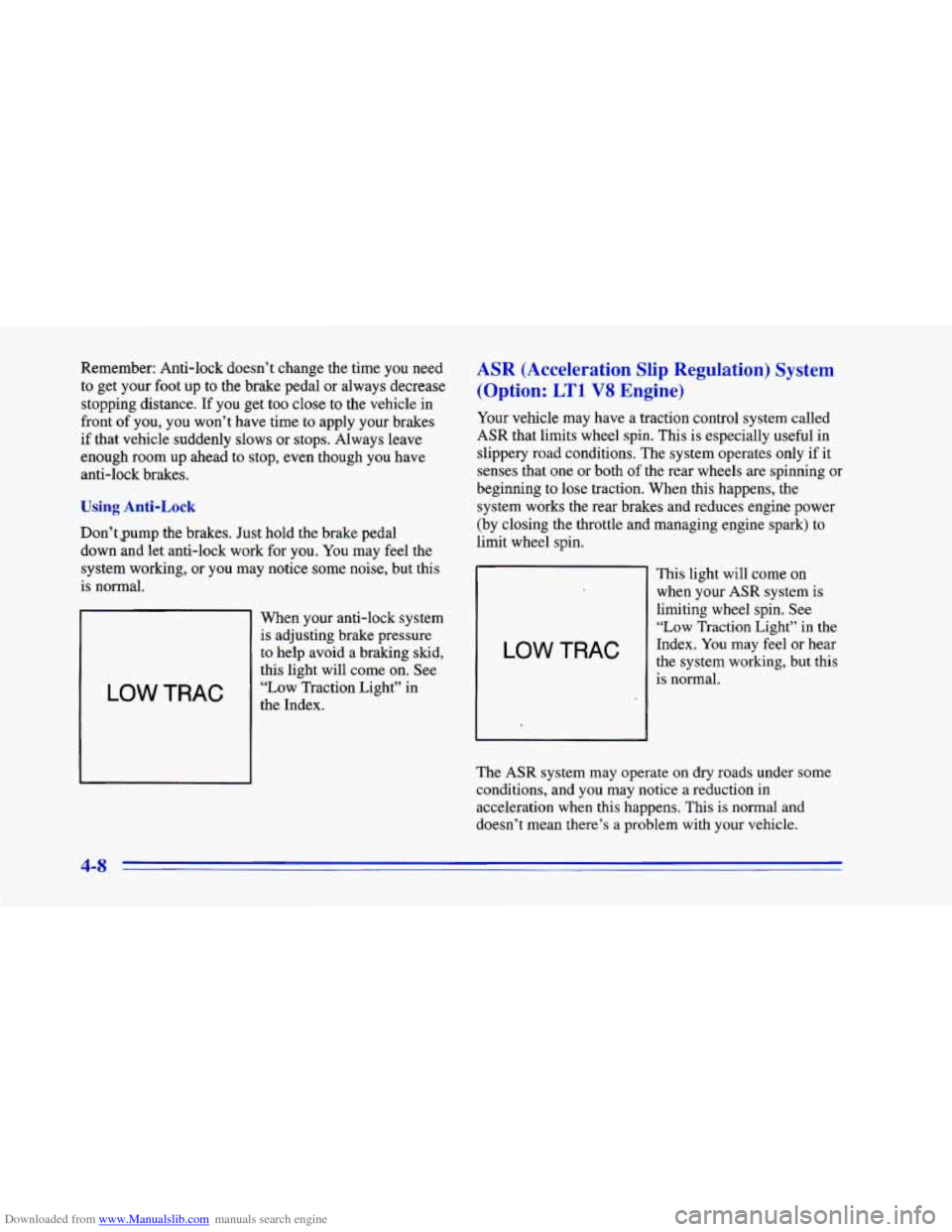
Downloaded from www.Manualslib.com manuals search engine Remember: Anti-lock doesn’t change the time you need
to get your foot up to the brake pedal or always decrease
stopping distance.
If you get too close to the vehicle in
front
of you, you won’t have time to apply your brakes
if that vehicle suddenly slows or stops. Always leave
enough room up ahead to stop, even though you have
anti-lock brakes.
Using Anti-Lock
Don’tpump the brakes. Just hold the brake pedal
down and let anti-lock work for you. You may feel the
system working, or you may notice some noise, but this
is normal.
LOW TRAC
When your anti-lock system
is adjusting brake pressure
to help avoid a braking skid,
this light will come on. See
“Low Traction Light” in
the Index.
ASR (Acceleration Slip Regulation) System
(Option:
LTl V8 Engine)
Your vehicle may have a traction control system called
ASR that limits wheel spin. This is especially
useful in
slippery road conditions. The system operates only if
it
senses that one or both of the rear wheels are spinning or
beginning to lose traction. When this happens, the
system works the rear brakes and reduces engine power
(by closing the throttle and managing engine spark) to
limit wheel spin.
LOW TRAC
This light will come on
when your ASR system is
limiting wheel spin. See
“Low Traction Light” in the
Index. You may feel or hear
the system working, but this
is normal.
The ASR system may operate
on dry roads under some
conditions, and you may notice a reduction in
acceleration when this happens. This is normal and
doesn’t mean there’s a problem with your vehicle.
4-8
Page 175 of 402
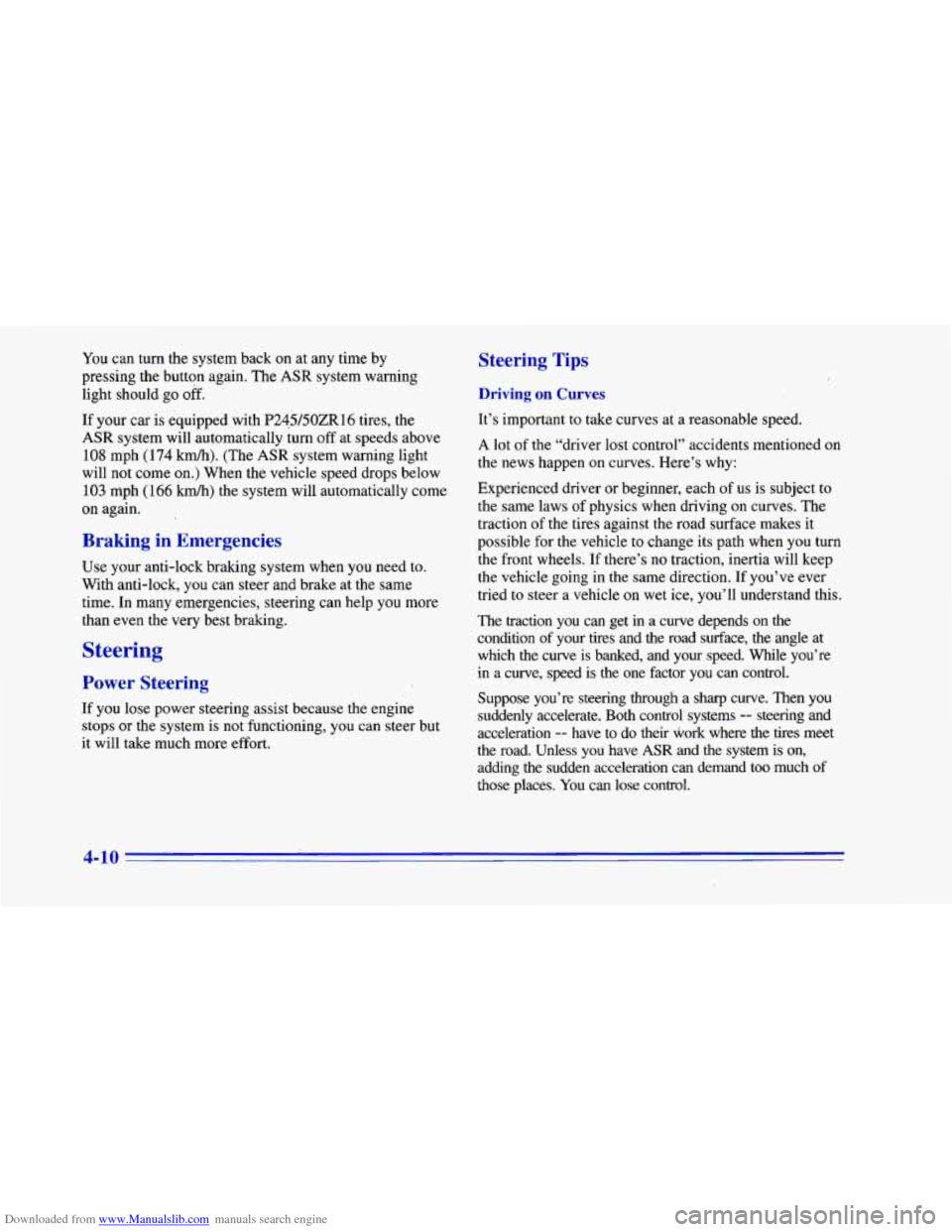
Downloaded from www.Manualslib.com manuals search engine You can turn the system back on at any time by
pressing the button again. The ASR system warning
light should go off.
If your car is equipped with P245/50ZR16 tires, the
ASR system will automatically turn off at speeds above
108 mph (174 kmh). (The ASR system warning light
will not come on.) When the vehicle speed drops below
103 mph (166 km/h) the system will automatically come
on again.
Braking in Emergencies
Use your anti-lock braking system when you need to.
With anti-lock, you can steer and brake at the same
time. In many emergencies, steering can help you more
than
even the very best braking.
Steering
Power Steering
If you lose power steering assist because the engine
stops or the system is not functioning, you can steer but
it will take much more effort.
Steering Tips
Driving on Curves
It’s important to take curves at a reasonable speed.
A lot of the “driver lost control” accidents mentioned on
the news happen on curves. Here’s why:
Experienced driver or beginner, each of
us is subject to
the same laws of physics when driving on curves. The
traction of the tires against the road surface makes it
possible for the vehicle to change its path when you turn
the front wheels.
If there’s no traction, inertia will keep
the vehicle going in the same direction. If you’ve ever
tried to steer a vehicle on wet ice, you’ll understand this.
The traction you can get in a curve depends on the
condition
of your tires and the road surface, the angle at
which the curve
is banked, and your speed. While you’re
in a curve, speed is the one factor you can control.
Suppose you’re steering through a sharp curve. Then you
suddenly accelerate. Both control systems
-- steering and
acceleration
-- have to do their work where the tires meet
the road. Unless you have ASR and the system is on,
adding the sudden acceleration can demand too much
of
those places. You can lose control.
Page 180 of 402
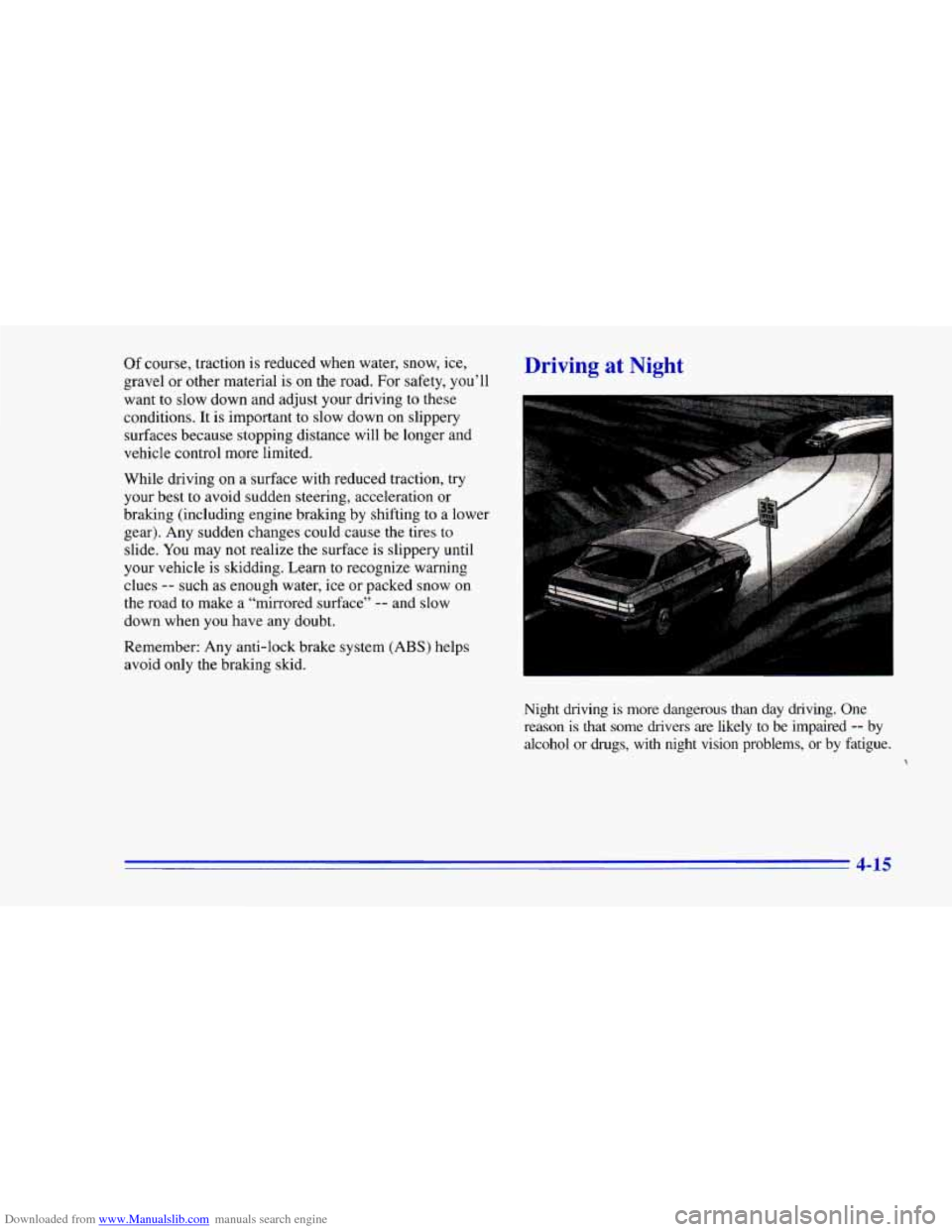
Downloaded from www.Manualslib.com manuals search engine Of course, traction is reduced when water, snow, ice,
gravel or other material is
on the road. For safety, you’ll
want
to slow down and adjust your driving to these
conditions. It is important to slow down on slippery
surfaces because stopping distance will be longer and
vehicle control more limited.
While driving
on a surface with reduced traction, try
your best
to avoid sudden steering, acceleration or
braking (including engine braking by shifting
to a lower
gear). Any sudden changes could cause the tires to
slide.
You may not realize the surface is slippery until
your vehicle is skidding. Learn to recognize warning
clues
-- such as enough water, ice or packed snow on
the road to make a “mirrored surface”
-- and slow
down when you have any doubt.
Remember: Any anti-lock brake system
(ABS) helps
avoid
only the braking skid.
Driving at Night
Night driving is more dangerous than day driving. One
reason
is that some drivers are likely to be impaired -- by
alcohol or drugs, with night vision problems, or by fatigue.
4-15
Page 303 of 402
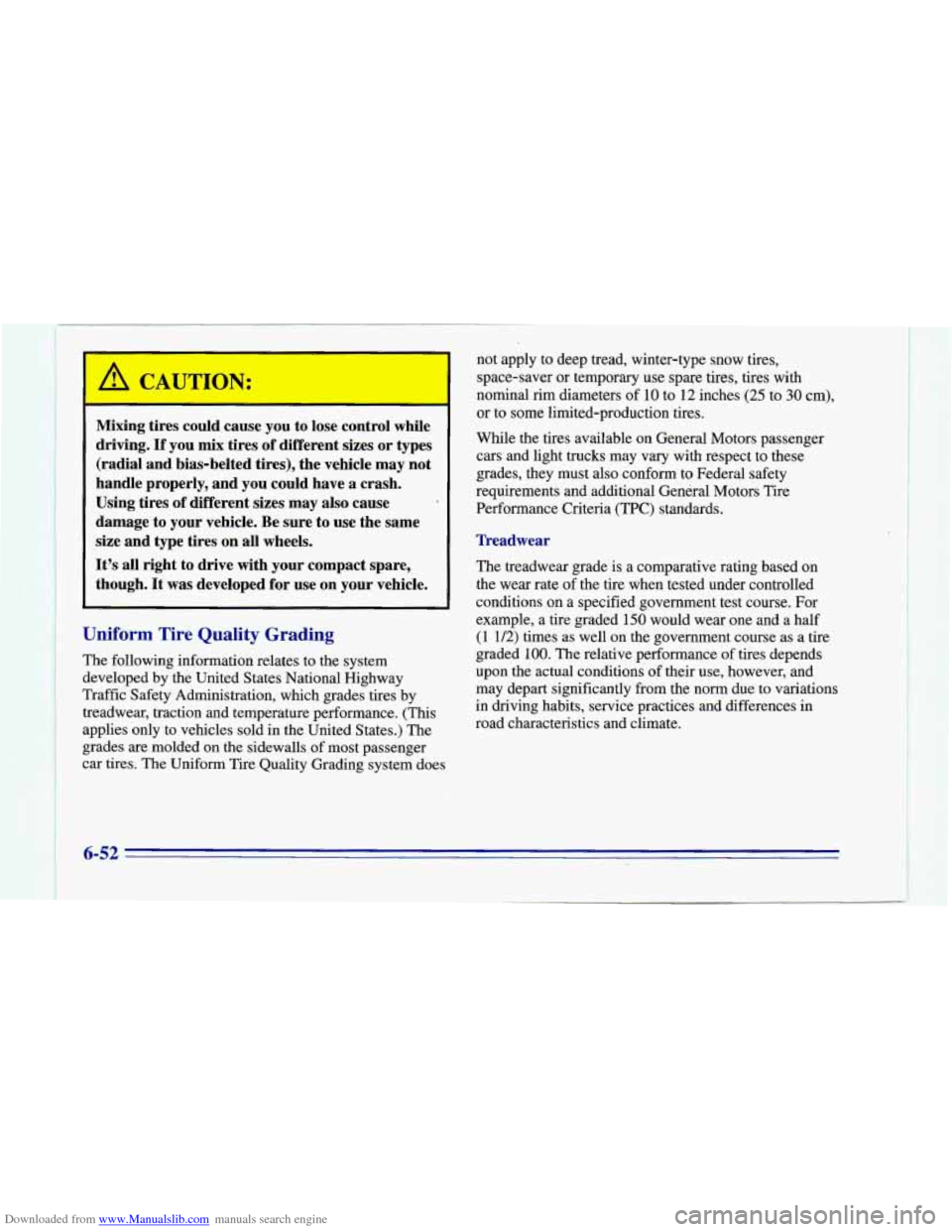
Downloaded from www.Manualslib.com manuals search engine Mixing tires could cause you to lose control while
driving.
If you mix tires of different sizes or types
(radial and bias-belted tires), the vehicle may not
handle properly, and you could have
a crash.
Using tires of different sizes may also cause
damage to your vehicle. Be sure to use the same
size and type tires on all wheels.
It's all right to drive with your compact spare,
though.
It was developed for use on your vehicle.
Uniform Tire Quality Grading
The following information relates to the system
developed by the United States National Highway
Traffic Safety Administration, which grades tires by
treadwear, traction and temperature performance. (This applies 'only to vehicles sold in the United States.) The
grades
are molded on the sidewalls of most passenger
car tires. The Uniform Tire Quality Grading system does not
apply to deep tread, winter-type snow tires,
space-saver
or temporary use spare tires, tires with
nominal rim diameters of
10 to 12 inches (25 to 30 cm),
or to some limited-production tires.
While the tires available on General Motors passenger
cars and light trucks may vary with respect to these
grades, they must
also conform to Federal safety
requirements and additional General Motors Tire
Performance Criteria (TPC) standards.
Treadwear
The treadwear grade is a comparative rating based on
the wear rate of the tire when tested under controlled
conditions on a specified government test course. For
example, a tire graded
150 would wear one and a half
(1 1/2) times as well on the government course as a tire
graded
100. The relative performance of tires depends
upon the actual conditions of their use, however, and
may depart significantly from the norm due to variations
in driving habits, service practices and differences in
road characteristics and climate.
6-52
Page 304 of 402
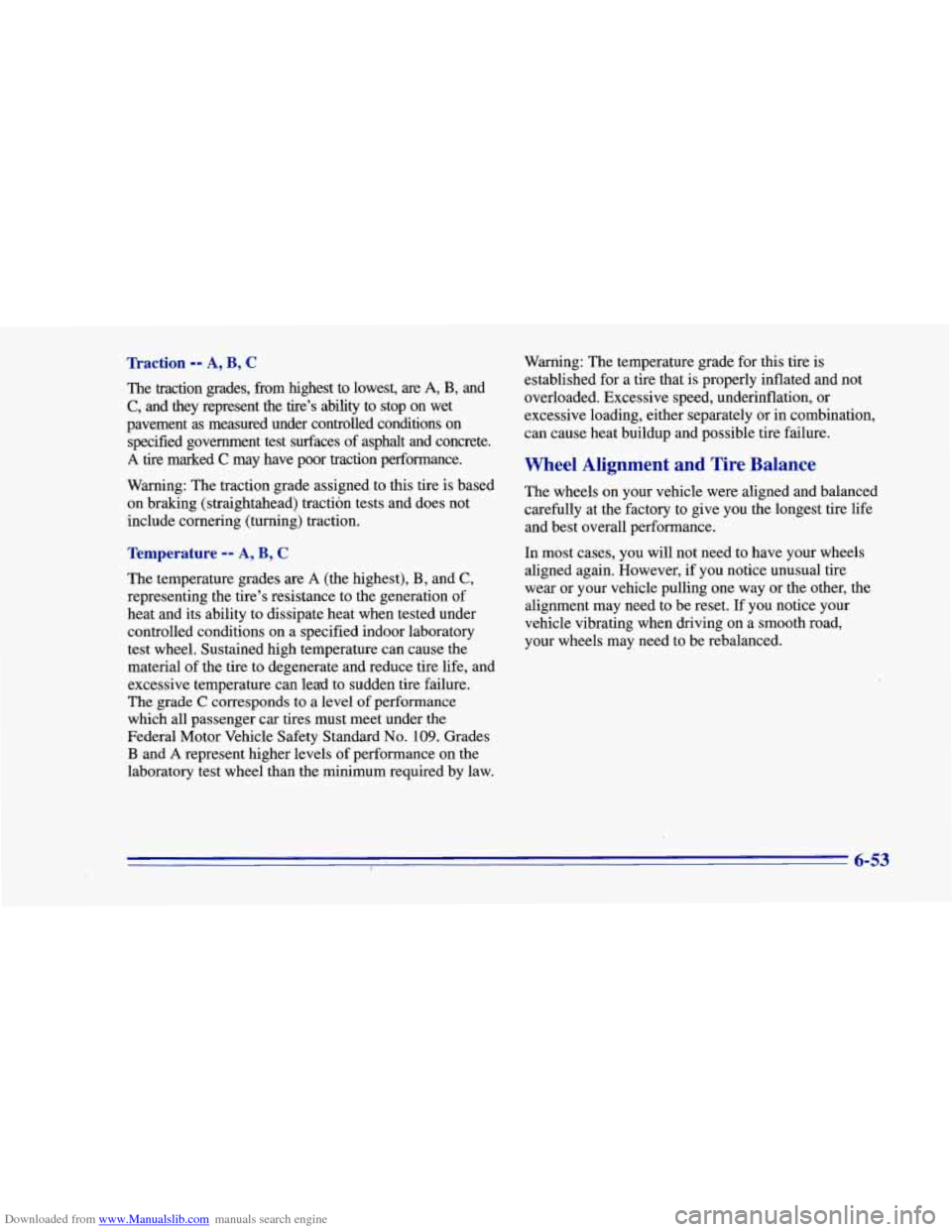
Downloaded from www.Manualslib.com manuals search engine =action -- A, B, C
The traction grades, from highest to lowest, are A, B, and
C, and they represent the tire’s ability to stop on wet
pavement
as measured under controlled conditions on
specified government test surfaces of asphalt and concrete.
A tire marked C may have poor traction performance.
Warning: The traction grade assigned to this tire
is based
on braking (straightahead) traction tests and does not
include cornering (turning) traction.
Temperature -- A, B, C
The temperature grades are A (the highest), B, and C,
representing the tire’s resistance to the generation of
heat and its ability to dissipate heat when tested under
controlled conditions on a specified indoor laboratory
test wheel. Sustained high temperature can cause the material of the tire to degenerate and reduce tire life, and
excessive temperature can lead to sudden tire failure.
The grade
C corresponds to a level of performance
which all passenger car tires must meet under the
Federal Motor Vehicle Safety Standard
No. 109. Grades
B and A represent higher levels of performance on the
laboratory test wheel than the minimum required by law. Warning: The temperature grade- for this tire is
established for a tire that is properly inflated and not
overloaded. Excessive speed, underinflation, or
excessive loading, either separately
or in combination,
can cause heat buildup and possible tire failure.
Wheel Alignment and Tire Balance
The wheels on your vehicle were aligned and balanced carefully at the factory to give you the longest tire life
and best overall performance.
In most cases, you will not need to have your wheels
aligned again. However, if
you notice unusual tire
wear or your vehicle pulling one way or the other, the
alignment may need to be reset. If you notice your
vehicle vibrating when driving on a smooth road,
your wheels may need to be rebalanced.
f 6-53
Page 319 of 402
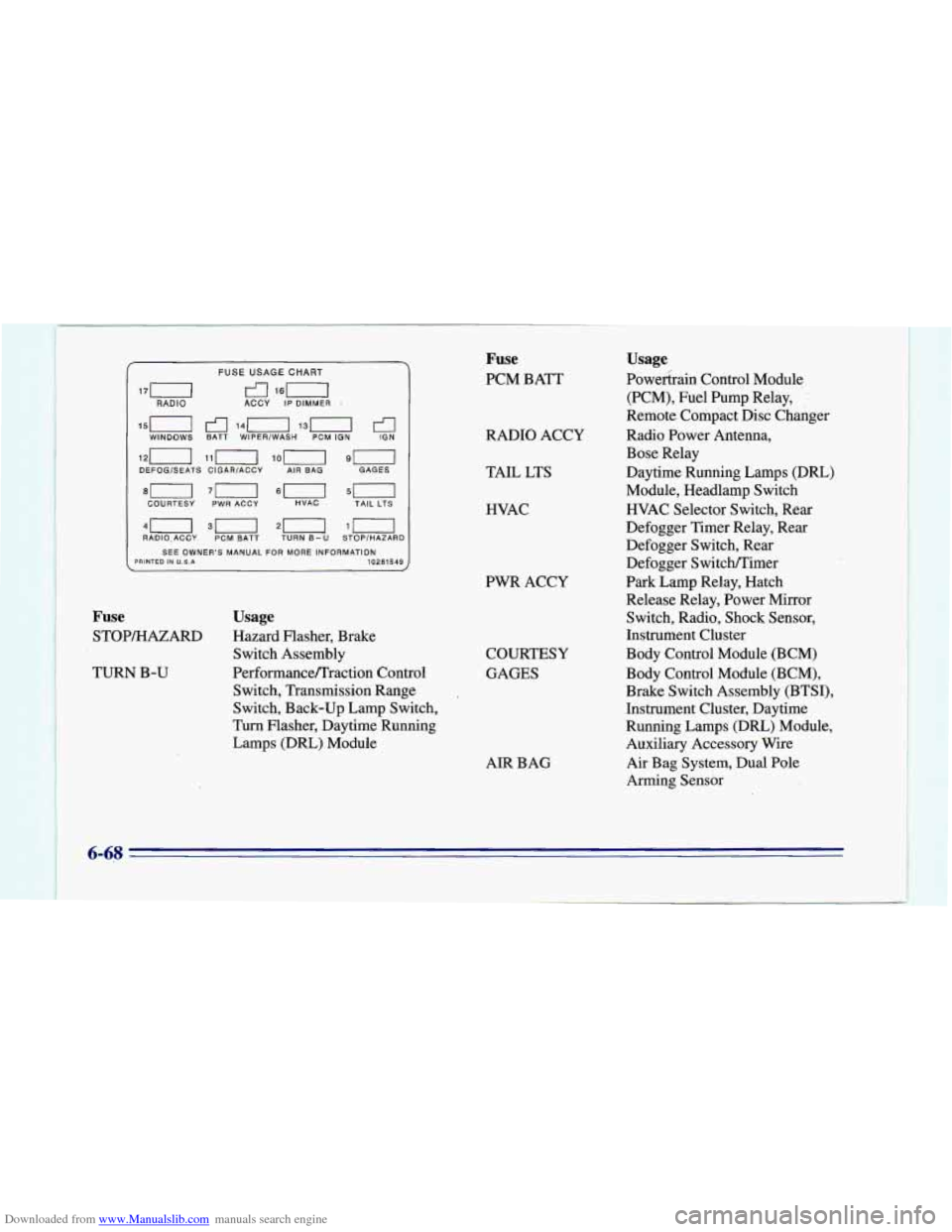
Downloaded from www.Manualslib.com manuals search engine 15n 141-1 13(1 WINDOWS BATT WIPER/WASH PCM ION €I IGN
DEFOGSEATS CIGAR/ACCY AIR BAG GAGES
COURTESY
PWR ACCY HVAC TAIL LTS
40 30 20 $0 RADIO.ACCY PCM BATT TURN B-U STOP/HAZARD
SEE OWNER’S MANUAL
FOR MORE INFORMATION PRINTED IN U.S.A 10281549
FUSE USAGE CHART
170 rl 160 RADIO ACCY IP DIMMER 1
Fuse Usage
STOP/HAZARD Hazard
Flasher, Brake
Switch Assembly
Switch, Transmission Range
Switch, Back-up Lamp Switch,
Turn Flasher, Daytime Running
Lamps (DRL) Module
TURN
B-U Performance/Traction Control
Fuse
PCM BATT
RADIO ACCY
TAIL LTS
HVAC
PWR ACCY COURTESY
GAGES
AIR BAG
Usage
Powekrain Control Module
(PCM), Fuel Pump Relay,
Remote Compact Disc Changer
Radio Power Antenna,
Bose Relay
Daytime Running Lamps
(DRL)
Module, Headlamp Switch
HVAC Selector Switch, Rear
Defogger Timer Relay, Rear
Defogger Switch, Rear
Defogger Switch/Timer
Park Lamp Relay, Hatch
Release Relay, Power Mirror
Switch, Radio, Shock Sensor,
Instrument Cluster
Body Control Module (BCM)
Body Control Module (BCM),
Brake Switch Assembly’(BTS1).
Instrument Cluster, Daytime
Running Lamps (DRL) Module,
Auxiliary Accessory Wire
Air Bag System, Dual Pole
Arming Sensor
6-68
Page 322 of 402
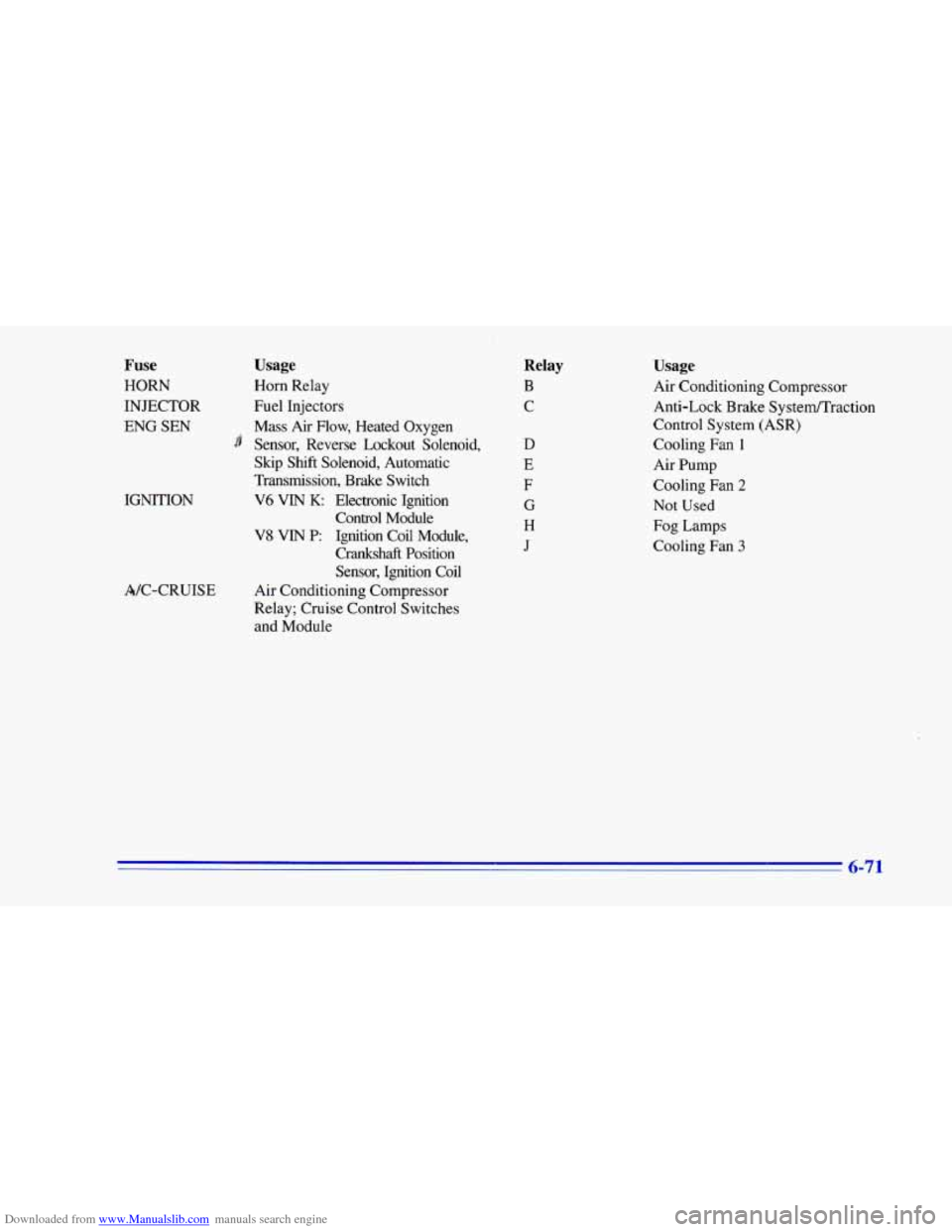
Downloaded from www.Manualslib.com manuals search engine Fuse
HORN INJECTOR
ENG SEN
IGNITION
A/C-CRUISE
Usage
Horn Relay
Fuel Injectors
~ Mass Air Flow, Heated Oxygen
fl Sensor, Reverse Lockout Solenoid.
Skip Shift Solenoid, Automatic
Transmission, Brake Switch
V6 VIN K: Electronic Ignition Control Module
V8 VIN P: Ignition Coil Module,
Crankshaft Position
Sensor, Ignition Coil
Air Conditioning Compressor
Relay; Cruise Control Switches
and Module
Relay
B
C
D
E
F
G
H
J
Usage
Air Conditioning Compressor
Anti-Lock Brake SystedTraction
Control System (ASR)
Cooling Fan
1
Air Pump
Cooling Fan
2
Not Used
Fog Lamps
Cooling Fan
3
6-71
Page 395 of 402
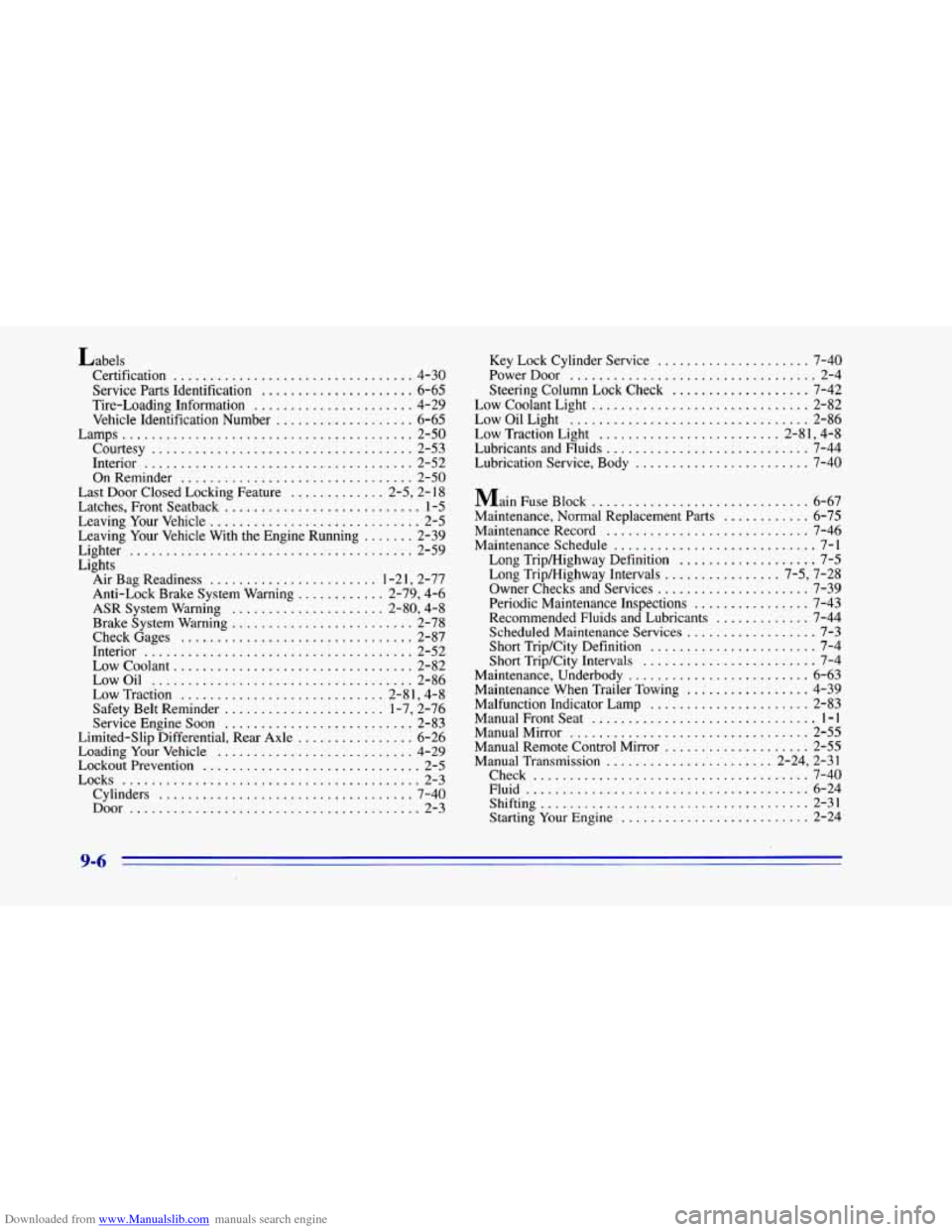
Downloaded from www.Manualslib.com manuals search engine Labels Certification
................................. 4-30
Service Parts Identification
..................... 6-65
Tire-Loading Information
...................... 4-29
Vehicle Identification Number
................... 6-65
Lamps
........................................ 2-50
Interior
..................................... 2-52
OnReminder
................................ 2-50
Last Door Closed Locking Feature
............. 2.5. 2. 18
Latches. Front Seatback
........................... 1-5
Leaving Your Vehicle With the Engine Running ....... 2-39
Lighter
....................................... 2-59
Lights Air Bag Readiness
....................... 1.21. 2.77
Anti-Lock Brake System Warning
............ 2.79. 4.6
ASR System Warning
..................... 2.80. 4.8
Brake System Warning
......................... 2-78
CheckGages
................................ 2-87
Interior
..................................... 2-52
LowCoolant
................................. 2-82
LowOil
.................................... 2-86
Low Traction
............................ 2-81. 4-8
Safety Belt Reminder
...................... 1-7. 2-76
Service Engine Soon
.......................... 2-83
Limited-Slip Differential, Rear Axle
................ 6-26
Loading Your
Vehicle ........................... 4-29
Lockout Prevention
.............................. 2-5
Cylinders
................................... 7-40
Door
........................................ 2-3
Courtesy
.................................... 2-53
Leaving Your Vehicle
............................. 2-5
Locks
......................................... 2-3
Key Lock Cylinder Service ..................... 7-40
PowerDoor
.................................. 2-4
Steering Column Lock Check
................... 7-42
Low Coolant Light
.............................. 2-82
LowOilLight
................................. 2-86
Low Traction Light
......................... 2.81. 4.8
Lubricants and Fluids
............................ 7-44
Lubrication Service. Body
........................ 7-40
Main Fuse Block
.............................. 6-67
Maintenance. Normal Replacement Parts
............ 6-75
Maintenance Record
............................ 7-46
Maintenance Schedule
............................ 7-1
Long Tripmighway Intervals ................ 7-5. 7-28
Owner Checks and Services
..................... 7-39
Periodic Maintenance Inspections
................ 7-43
Recommended Fluids and Lubricants
............. 7-44
Scheduled Maintenance Services
.................. 7-3
Short Trip/City Definition
....................... 7-4
Short Trip/City Intervals
........................ 7-4
Maintenance When Trailer Towing
................. 4-39
Malfunction Indicator Lamp
...................... 2-83
ManualFrontSeat
............................... 1-1
Manual Mirror ................................. 2-55
Manual Remote Control Mirror
.................... 2-55
Manual Transmission
....................... 2-24. 2-31
Check
...................................... 7-40
Fluid
....................................... 6-24
Shifting
..................................... 2-31
Starting Your Ennine
.......................... 2-24
Long
Tripmighway Definition
................... 7-5
Maintenance. Underbody
......................... 6-63
Page 399 of 402
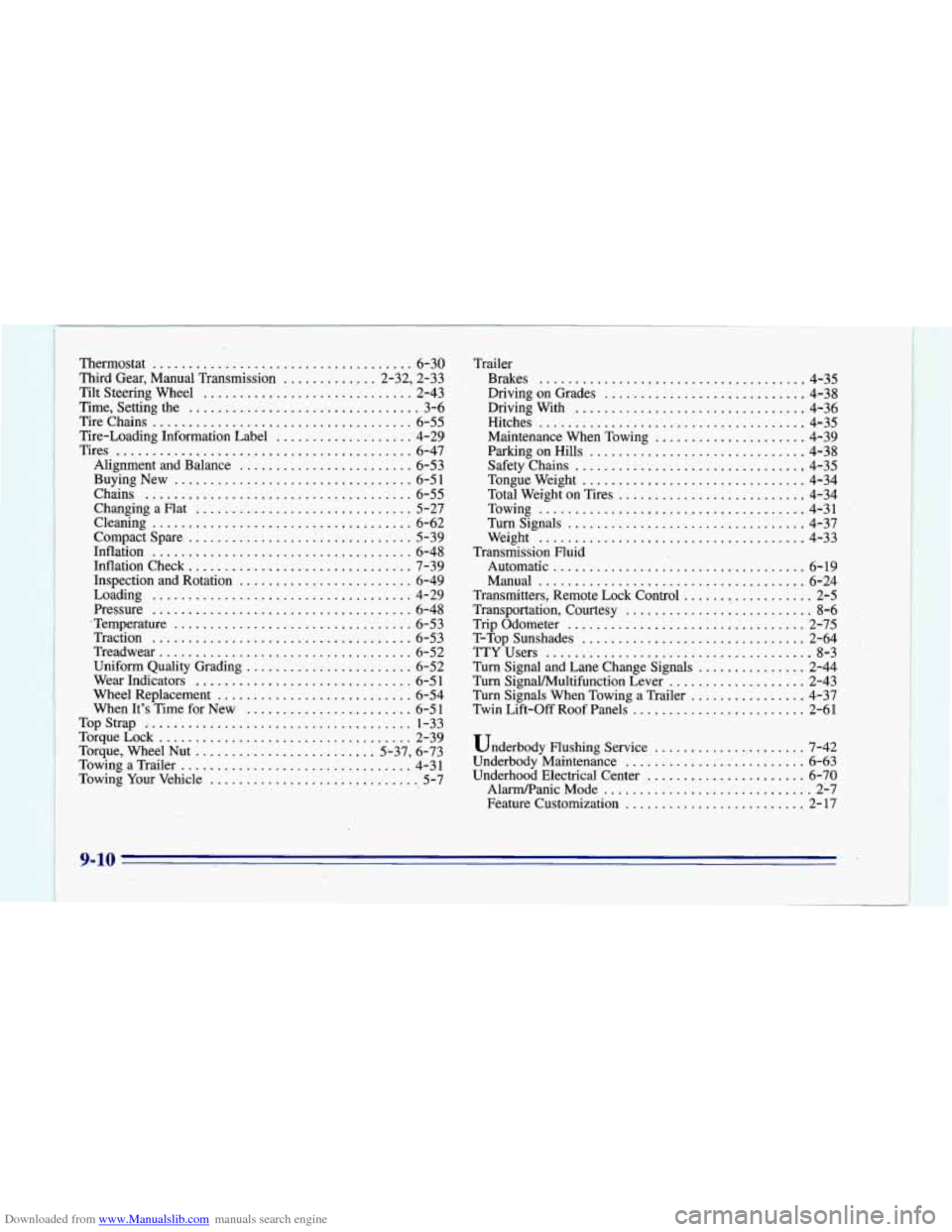
Downloaded from www.Manualslib.com manuals search engine Thermostat .................................... 6-30
Third Gear. ManuaLTransmission
.......... .. .. 2-32. 2-33 .
Tilt Steering Wheel ..................... ; ....... 2-43
Time. Setting the
................................ 3-6
Tirechains
.................................... 6-55
Tire-Loading Information Label
................... 4-29
Tires
......................................... 6-47
Alignment and Balance
........................ 6-53
Buying New
................................. 6-5 1
Chains
..................................... 6- 55
Changing a
Flat .............................. 5-27
. Cleaning .................................... 6-62
Compact Spare
................................ 5-39
. Inflation .................................... 6-48
Inflation Check
................................ 7-39
Inspection and Rotation
........................ 6-49
Loading
.................................... 4-29
Pressure
.................................... 6-48
..Temperature
................................. 6-53
Traction
.................................... 6-53
Treadwear
.................................... 6-52
Uniform Quality Grading
....................... 6-52
Wear Indicators
.............................. 6-5 1
Wheel Replacement
........................... 6-54
When It’s Time for New
...................... ; 6-51
TopStrap
.................................... 1-33
TorqueLock
................................... 2-39
Torque. Wheel Nut
......................... 5-37. 6-73
TowingaTrail
er ................................. 4-31
Towing Your Vehicle
.............................. 5-7 Trailer
Brakes
..................................... 4-35
Driving
on Grades ............................ 4-38
DrivingWith
................................ 4-36
Hitches
..................................... 4-35
Maintenance When Towing
..................... 4-39
Parking on Hills
.............................. 4-38
Safety Chains
................................. 4-35
Tongue Weight
............................... 4-34
Total Weight on Tires
.......................... 4-34
Towing
...................................... 4-31
Turn Signals
...................... : .......... 4-37
Weight
...................................... 4-33
Automatic
................................... 6-19
Manual
..................................... 6-24
Transmitters, Remote Lock Control
...... ........... 2-5
Transportation, Courtesy
.......................... 8-6
Trip Odometer
................................. 2-75
TTYUsers 8-3
Transmission Fluid
T-Top Sunshades
............................... 2-64 ..
Turn Signal and Lane Change Signals ............... 2-44
Turn SignaVMultifunction Lever ................... 2-43
Turn Signals When Towing a Trailer ................ 4-37
Twin Lift-off
Roof Panels ........................ 2-61
.. .....................................
Underbody Flushing Service ............ ......... 7-42
Underbody Maintenance
......................... 6-63
Underhood Electrical Center
...................... 6-70
Alarm/Panic Mode
............................. 2-7
Feature Customization
......................... 2-17
9-10